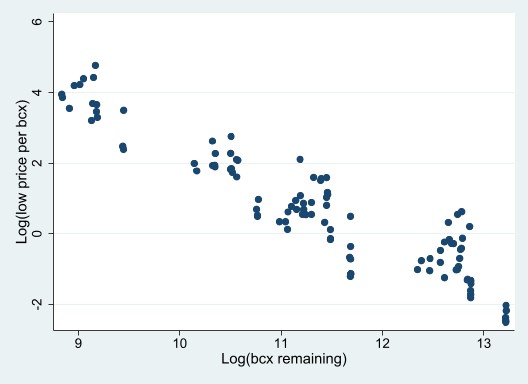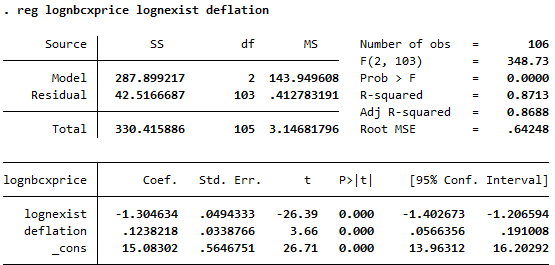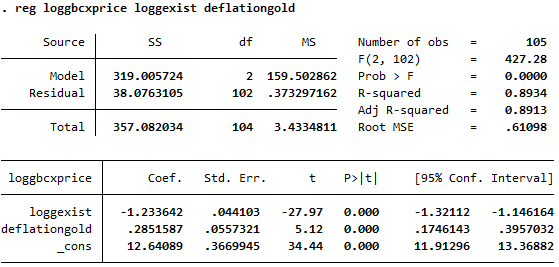Cross-sectional regression comparison between normal and gold foil reward cards
Hello, and welcome to my first Splintertalk focused purely on market analysis.
Today we will be looking at some different statistics regarding the reward cards in Splinterlands and their market performance. Rather than a time series analysis, where prices observed over time is mapped, here we shall be looking at a cross-sectional dataset, made by updating the csv file available at https://kiokizz.github.io/Splinterlands/rewardCards.html with additional information from https://www.splintercards.com/tool-distribution.html?ed=3. All price and circulation data are thus from days date.
Here I have plottet the log of price per bcx against the amount of bcx in existence first for normal foil and the gold foil:


As could be expected there seems to be a clear relationship between the variables considered. I constructed a price model based on a rather simple idea, which looks like the following:
Where N is the total amount of bcx in existence and delta is a measure of the overall deflation of the original amount of BCX, given by Total bcx printed divided by the amount of cards left in circulation. This will incapsulate the fact that cards that are played more/at higher levels will have been combined more frequently. Thus this ratio can be used as a proxy for the cards popularity in ranked play.
Below are the results of the regressions for normal and then foil bcx prices:
The results are as followed: All the variables considered have significant influence on the bcx price at a 95% confidence interval. The coefficients are positive for the deflation variable and negative for the total bcx value as expected. This means that the ratio of total bcx/cards left (which becomes larger as more cards are burned) has a coefficient around .1 for normal foil and .2 for gold foil. The exact interpretation of this coefficient however is a bit complicated, because of the way the variables are constructed.
For the total bcx remaining variable, the coefficients are -1.3 for normal foil and -1.4 for gold foil. This being a log - log relation, means that this can be intepreted as a 1% increase in supply will give a 1.3% or 1.4% fall in price per bcx for normal and gold foil respectively.
Despite both normal and gold foils being influenced by both variables considered, it is interesting to see that for normal foils the overall quantity is more important relative to for gold foils, whereas the opposite is true for the deflation variable. This could be explained by 2 things: gold foil has more baseline utility due to higher level, more power, and more DEC earnings from battles or renting out. Therefore its price is affected by more outside factors than just supply relative to normal foils. The second explanation could be that gold foils are worth a higher premium for meta and desired cards. This is more of a psychological factor, but the most desired cards in the game can attain a status of becoming luxury goods, meaning that demand for them actually rises with their price. Not saying this is the case, but I think similar dynamics might be at play.
Disclaimer: This analysis isn't meant as financial advice. All statistical analysis done by myself, and might be subject to errors, feel free to inquire if you have any questions though!
Anyways, that is all for now! I hope you gained some insight from my analysis, and welcome you to comment down below if you have any remarks. And thank you for coming to my Splintertalk.
/ZenMasterLee



Congratulations @zenmasterlee! You have completed the following achievement on the Hive blockchain and have been rewarded with new badge(s) :
Your next target is to reach 50 upvotes.
You can view your badges on your board and compare yourself to others in the Ranking
If you no longer want to receive notifications, reply to this comment with the word
STOPTo support your work, I also upvoted your post!
Check out the last post from @hivebuzz: